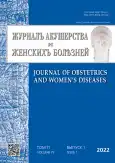Эффективность использования управляемой баллонной тампонады для остановки послеродового атонического кровотечения
- Авторы: Бабажанова Ш.Д.1, Любчич А.С.1, Любчич Н.И.1
-
Учреждения:
- Республиканский перинатальный центр
- Выпуск: Том 71, № 1 (2022)
- Страницы: 5-10
- Раздел: Оригинальные исследования
- Статья получена: 26.09.2020
- Статья одобрена: 24.12.2021
- Статья опубликована: 15.01.2022
- URL: https://journals.eco-vector.com/jowd/article/view/46050
- DOI: https://doi.org/10.17816/JOWD46050
- ID: 46050
Цитировать
Аннотация
Обоснование. Акушерские кровотечения остаются ведущей причиной материнской смертности в Узбекистане, при этом наиболее частой причиной является атония матки в последовом и послеродовом периодах.
Цель — оценить эффективность баллонной тампонады матки при послеродовых атонических кровотечениях.
Материалы и методы. Исследование проведено в Республиканском перинатальном центре МЗ РУз с 2016 по 2019 г. Дизайн исследования: клиническое контролируемое исследование. Баллонная тампонада матки с применением баллона Жуковского использована у 50 родильниц с послеродовым атоническим кровотечением, из них через естественные родовые пути разрешены 40 женщин и путем кесарева сечения 10 пациенток. Группу контроля составили 50 родильниц с послеродовым атоническим кровотечением, которым проводили традиционную терапию без применения баллонной тампонады матки, из них через естественные родовые пути родоразрешены 40 женщин и путем кесарева сечения 10 пациенток.
Результаты. В основной группе, в которой кроме стандартного комплексного лечения атонического кровотечения применяли баллонную тампонаду матки, общий объем кровопотери был достоверно ниже — 998 ± 142 и 1498 ± 202 мл при вагинальных родах (t-критерий Стьюдента — 2,01; p = 0,047563) и 1297 ± 244 и 1988 ± 226 мл при кесаревом сечении (t-критерий Стьюдента — 2,11; p = 0,039463), чем в группе без баллонной тампонады матки. Баллонная тампонада матки позволила остановить послеродовое кровотечение в диапазоне кровопотери 750–999 и 1000–1499 мл в 27,5 и 52,5 % случаях, тогда как этот показатель в контрольной группе составил 20 и 30 % случаев соответственно (OШ 1,517; 95 % ДИ 1,536–4,293 и OШ 2,579; 95 % ДИ 1,030–6,457). Доля массивных кровотечений (кровопотеря свыше 1500 мл) при использовании баллонной тампонады матки была в 3,8 раза меньше, чем в контрольной группе: 10,0 % (5/50) и 38 % (19/50) соответственно. Гистерэктомия вследствие кровотечения в основной группе выполнена одной (2 %) родильнице, а в контрольной группе — пяти (10 %) пациенткам (ОШ 0,184; 95 % ДИ 1,021–6,133). Благодаря «тампонадному тесту» удалось достоверно уменьшить количество тяжелых кровотечений в диапазоне 1500 мл и более при вагинальных родах на 90 % (ОШ 0,077; 95 % ДИ 0,009–0,635), в 2,9 раза повысить эффективность органосохраняющих операций и увеличить частоту женщин с сохраненной маткой.
Заключение. Эффективность баллонной тампонады матки при послеродовом атоническом кровотечении составила 88,0 % (44/50). Простота и безопасность применения баллонной тампонады матки свидетельствует о необходимости более широкого внедрения данной технологии при послеродовых кровотечениях, что будет способствовать уменьшению количества неблагоприятных исходов.
Ключевые слова
Полный текст
Об авторах
Шахида Дадажановна Бабажанова
Республиканский перинатальный центр
Автор, ответственный за переписку.
Email: shohida_bd@mail.ru
канд. мед. наук, заведующая акушерским отделением
Узбекистан, 100164, Ташкент, ул. Богишамол, д. 223аАделина Семеновна Любчич
Республиканский перинатальный центр
Email: shohida_bd@mail.ru
канд. мед. наук
Узбекистан, 100164, Ташкент, ул. Богишамол, д. 223аНаталья Ивановна Любчич
Республиканский перинатальный центр
Email: shohida_bd@mail.ru
кандидат мед. наук, заведующая акушерским отделением
Узбекистан, 100164, Ташкент, ул. Богишамол, д. 223аСписок литературы
- World Health Organization [Internet]. Trends in maternal mortality 2000 to 2017: estimates by WHO, UNICEF, UNFPA, World Bank Group and the United Nations Population Division: executive summary. 2019. [дата обращения 23.09.2021]. Доступ по ссылке: https://apps.who.int/iris/handle/10665/327596
- Say L., Chou D., Gemmill A. et al. Global causes of maternal death: a WHO systematic analysis // Lancet. Glob. Health. 2014. Vol. 2. No. 6. P. e323−e333. doi: 10.1016/S2214-109X(14)70227-X
- Kassebaum N.J., Bertozzi-Villa A., Coggeshall M.S. et al. Global, regional, and national levels and causes of maternal mortality during 1990-2013: a systematic analysis for the Global Burden of Disease Study 2013 // Lancet. 2014. Vol. 384 (9947). P. 980−1004. doi: 10.1016/S0140-6736(14)60696-6
- Hogan M.C., Foreman K.J., Naghavi M. et al. Maternal mortality for 181 countries, 1980-2008: a systematic analysis of progress towards Millennium Development Goal 5 // Lancet. 2010. Vol. 375 (9726). P. 1609−1623. doi: 10.1016/S0140-6736(10)60518-1
- Gupta M., Mitesh J. Role of condom catheter balloon tamponade in management of atonic postpartum haemorrhage in cases of failed medical management // Int. J. Clin. Obstet. Gynaecol. 2017. Vol. 1. No. 2. P. 62−64.
- Sharma A., Bansal N., Ramola M. et al. Bakri postpartum balloon: an obstetrician’s armamentarium in managing post-partum haemorrhage // Int. J. Reprod. Contracept. Obstet. Gynecol. 2020. Vol. 9. No. 5. P. 2113−2117. doi: 10.18203/2320-1770.ijrcog20201814
- Во имя спасения жизни матерей. Третий отчет по конфиденциальному исследованию случаев материнской смертности (за 2016–2017 гг.). Ташкент, 2020. [дата обращения 23.08.2021]. Доступ по ссылке: https://uzbekistan.unfpa.org/sites/default/files/pub-pdf/kisms_3-y_nac_otchet_2016-2017.pdf
- Frenzel D., Condous G.S., Papageorghiou A.T., McWhinney N.A. The use of the “tamponade test” to stop massive obstetric haemorrhage in placenta accrete // BJOG. 2005. Vol. 112. No. 5. P. 676−677. doi: 10.1111/j.1471-0528.2005.00491.x
- Condous G.S., Arulkumaran S., Symonds I. et al. The “tamponade test” in the management of massive postpartum hemorrhage // Obstet. Gynecol. 2003. Vol. 101. No. 4. P. 767−772. doi: 10.1016/s0029-7844(03)00046-2
- Suarez S., Conde-Agudelo A., Borovac-Pinheiro A. et al. Uterine balloon tamponade for the treatment of postpartum hemorrhage: a systematic review and meta-analysis // Am. J. Obstet. Gynecol. 2020. Vol. 222. No. 4. P. 293.e1−293.e52. doi: 10.1016/j.ajog.2019.11.1287
Дополнительные файлы







